In the developing world, more than 200 million children under the age of five years are at risk of not reaching their full development potential because they suffer from the negative consequences of poverty, nutritional deficiencies and inadequate learning opportunities. Overall, 165 million children (one in four) are stunted, and 90 percent of these children live in Africa and Asia. And though some progress has been made globally, child malnutrition remains a serious public health problem with enormous human and economic costs. Worldwide, only about 50 percent of children are enrolled in preprimary education, and in low-income countries a mere 17 percent. And though more and more children are going to school, millions have little to show for it. By some accounts, 250 million children of primary school age cannot read even part of a sentence. Some of these children have never been to school (58 million); but more often, they perform poorly despite having spent several years in school, which reflects not only the poor quality of many schools but also the multiple disadvantages that characterize their early life.
Ensuring that all children—regardless of their place of birth and parental income or education level—have access to opportunities that will allow them to reach their full potential requires investing early in their development. To develop their cognitive, linguistic, socioemotional and physical skills and abilities, children need good nutrition and health, opportunities for play, nurture and learning with caregivers, early stimulation and protection from violence and neglect.
The Case for Early Interventions
The arguments for investing in children early are simple and convincing. Early investment makes sense scientifically. The brain is almost fully developed by age three, providing a prime opportunity to achieve high gains. We know that the rapid rate of development of the brain’s neural pathways is responsible for an individual’s cognitive, social and emotional development, and there is solid evidence that nutrition and stimulation during the first 1,000 days of life are linked to brain development.
Early investment makes sense in terms of equity. The playing field has the highest chances of being leveled early on, and we know that programs have a higher impact for young children from poorer families. In the United States, for example, increasing preschool enrollment to 100 percent for low-income children would reduce disparities in school readiness by 24 percent between black and white children and by 35 percent between Hispanic and white children. We also know that equalizing initial endowments through early childhood development (ECD) programs is far more cost-effective than compensating for differences in outcomes later in life.
Early investment makes sense economically. Investing early prevents higher costs down the road, and interventions yield a high return on investment. There is evidence of the benefits for the individual and for society more broadly. For instance, at the level of the individual, in Jamaica children participating in an early childhood stimulation program were found to have 25 percent higher earnings 20 years later compared with children who did not participate. At the economy-wide level, eliminating malnutrition is estimated to increase gross domestic product by 1 to 2 percentage points annually, while countries with school systems that have a 10-percentage-point advantage in the proportion of students
The Brookings Institution is committed to quality, independence, and impact.
We are supported by a diverse array of funders. In line with our values and policies, each Brookings publication represents the sole views of its author(s).







